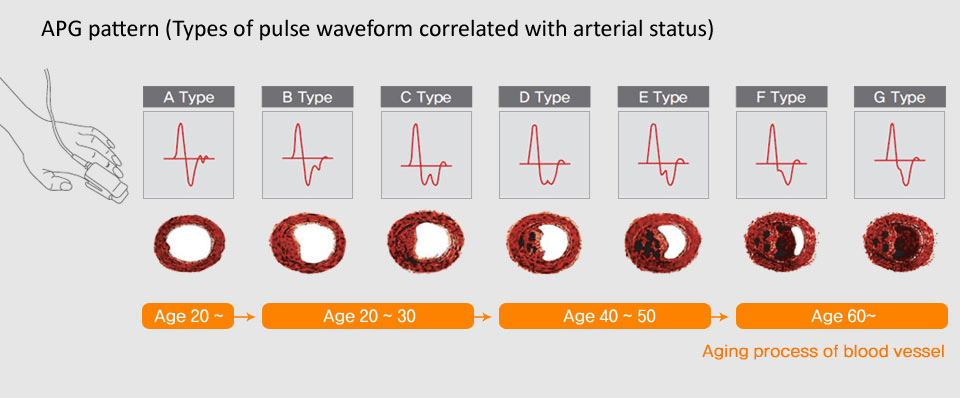MCARETECH
Home > Theory > APG
APG
| How is the Age of Your Arteries? |
|---|
 Max Pulse & Smart Pulse have the ability to know the health of our blood vessels which directly affects our overall cardiovascular health by analyzing your pulse waveforms.
Max Pulse & Smart Pulse have the ability to know the health of our blood vessels which directly affects our overall cardiovascular health by analyzing your pulse waveforms.
|
| Photoplethysmography (PTG) ? |
|
PTG is a non-invasive technique for measuring the amount of blood flow present or passing through, an organ or other part of the body. Plethysmography is used to diagnose deep vein thrombosis and arterial occlusive disease. Photoplethysmographs have been around for over 25 years and are currently being used in many clinical applications. Photoplethysmography is classified into two groups in terms of physical characteristics of parameters. One is “pressure Photoplethsmography”, which represents the change of intravascular pressure. The other is “Volume Capacity Photoplethysmography”, which indicates the change of vascular volume capacity. Volume Capacity Photoplethysmography is then classified into three categories by signal processing method for velocity. The categories are Photoplethysmography (PTG), Velocity Pulse Photoplethysmography, and Accelerated Photoplethysmography (APG). The Smart Pulse & Max Pulse use PTG and APG analysis. Specifically, the PTG and APG applications for determining aging vascular health and Heart Rate Variability(HRV). |
| Accelerated Plethysmography (APG) ? |
| Using a finger clip, the blood’s pulse wave is followed from the time it leaves the heart and travels through the blood vessels down to the finger. The pulse wave is a snapshot into the cardiovascular system and evaluates arterial elasticity (arterial stiffness), which is related to atherosclerosis. Arterial stiffness is a major cardiovascular risk factor. There is strong scientific evidence supporting the use of plethysmography as a diagnostic and prognostic tool for early warning signs of cardiovascular disease and peripheral vascular disease (including primary and secondary Raynaud`s phenomenon). |
| What are the clinical applications of APG? |
|
- Assess the peripheral blood circulation disorder - Evaluate the process and prediction of arteriosclerosis - Cardiovascular disease such as Myocardial Infarction - Indicator of general health |